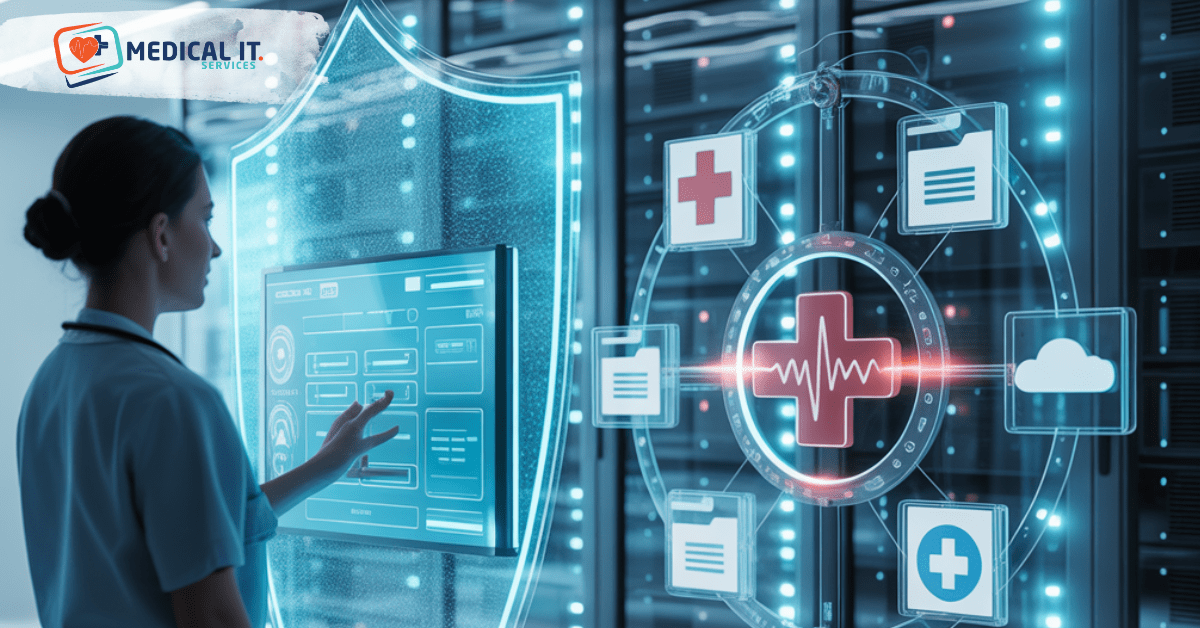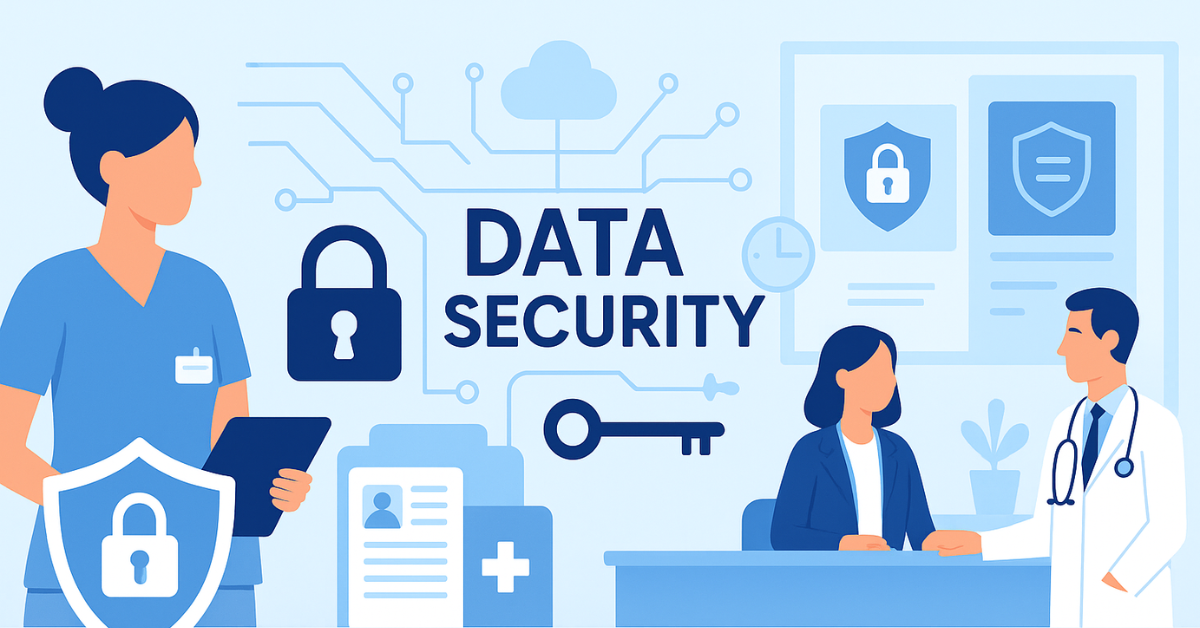In the modern world, technology is used to run practically every aspect of a corporation…

How Specialised Healthcare IT Services Protect Patient Data
The server is an instrument that has been added to the modern healthcare IT services, joining the stethoscope and the scalpel as necessary tools. The server is an equally significant instrument that has contributed to the modern healthcare environment. The digitization of health data has unlocked potential. That has never been seen before in terms of improving the results for patients. It optimizes operations and expands medical research via the advancement of medical research. The patient’s medical history, diagnostic photos, treatment plans, and billing information are all included in one document. The need to protect the personal information of patients lies at the heart of this digital transformation. This is a fundamental requirement that cannot be compromised in any way.
In addition to being comprised of facts, the information pertains to patients. It also includes the most private and delicate parts of a person’s life story. When it is compromised, it has the potential to result in considerable emotional grief, as well as financial loss, identity theft, and prejudice. In light of this, the systems that are accountable for storing, processing, and transferring this information. That cannot rely on commercially available conventional information technology solutions that are conventional. To prevent unwanted access to sensitive data, it is necessary to have a castle. That is designed and maintained by support IT services, which is a specialized, multi-layered fortress.
This article’s objective is to give a comprehensive analysis of the sophisticated strategies, technologies, and processes. These small business it services are used to maintain the patients’ anonymity and continually ensure their safety throughout their treatment.
Unique Value—and Vulnerability—of Health Data
Before one can have a complete understanding of the importance of a specialty, it is essential to first understand the variables. This contributes to the fact that health data is such a highly sought-after objective. Although a credit card number may be canceled and reissued after it has been used, a health record is more permanent than a credit card number.
- Comprehensiveness: An electronic health record, also known as an EHR, is a comprehensive profile that includes the following information about a patient: the patient’s name, address, date of birth, Social Security number, insurance information, and, most importantly, the patient’s medical history, diagnoses, medical prescriptions, and genetic information. The electronic health record has this profile.
- Immutable Nature: In contrast to financial information, a person’s medical history is something that cannot be changed. Because a diagnosis of a mental health issue or a chronic ailment that was made in the past cannot be changed. It is a potent tool that may be used for discrimination or blackmail over an extended period.
- High Black-Market Value: On the dark web, the cost of a complete medical record might be up to ten times more than the cost of a credit card number with the same information. False medical claims, fraudulent prescription pharmaceutical scams, and intricate identity theft schemes are all examples of those that make use of this information.
Because of the perfect storm of value and sensitivity that exists inside healthcare firms, cybercriminals are especially interested in breaking into these organizations. It is not enough to just have a conventional firewall to guard against these hazards. One must have a comprehensive understanding of both the technology and the complex clinical procedures that it maintains.
Multi-Layered Defense Strategy Proactive, Not Reactive, Posture
In the field of healthcare information technology, remote IT support function according to the philosophy of defense in depth. Creating many levels of protection that overlay one another is necessary to ensure that, if one layer is compromised, other layers are prepared to limit the danger. This tactic may be divided into a few major categories for easier comprehension.
1)-Access Control and Identity Management
The first and most important line of defense is to make sure that only people who are authorized to access the data may do so.
Role-Based Access Control (RBAC):
On the other hand, the creation of specialized systems does not make use of any universal access paradigm. One of the benefits of RBAC is that it ensures the data that a user is allowed to see is based on the function that they play within the business itself. A radiologist may demand imaging tests, whereas a pharmacist would need prescription lists. The only thing that a receptionist might desire is accessed to arrange appointments. On the other hand, a radiologist might require drug orders. It is closely adhered to that the principle of Least Privilege be followed. It implies that users are only granted the bare minimum of access that is necessary for them to carry out their responsibilities.
Multi-Factor Authentication (MFA):
Only passwords are famously difficult to crack. MFA adds essential levels by necessitating a second (or perhaps a third) source of verification at the very least. A code that is delivered to a mobile device, a biometric scan (fingerprint or face recognition), or a physical security key might all be suitable options for this. With only this one easy step, the great majority of assaults that are dependent on credentials are foiled.
Privileged Access Management (PAM):
On the other hand, system administrators and members of the IT team who have wide access are subject to limits that are far more rigorous than those that are placed on regular users. Personal access management (PAM) systems are an integral part of the administration and monitoring of super-user accounts. These systems are responsible for managing and monitoring these accounts. It is common practice for these solutions to need a reason for access to be regarded as legitimate. Every activity that takes place during a session is documented.
2)-Encryption in Transit and at Rest
Encryption is the act of converting data that can be read (also known as plaintext) into a format that cannot be read (also known as ciphertext). Plaintext is frequently referred to as plaintext. Encryption devices are used worldwide by information technology companies that specialize in the healthcare industry.
- Data at Rest Encryption: The process of encryption is applied to all the patient information that is stored on backup tapes, in databases, and on servers inside the organization. If the one-of-a-kind decryption key is not present, the data will continue to be inaccessible. This is true regardless of whether a physical hard drive is stolen or a cloud storage account is compromised.
- Data in Transit Encryption: Whenever data is transmitted, whether it be between a doctor’s tablet and the server at the hospital, between a clinic and a lab, or between multiple healthcare providers, it is subjected to sophisticated protocols such as Transport Layer Security (TLS) to ensure its safety. This avoids “man-in-the-middle” attacks, which are assaults in which data is intercepted while it is being transferred. These attacks are prevented by the development of a secure “tunnel,” which helps prevent these attacks.
3)-Advanced Threat Detection and Prevention
There is no longer a need for reactive security, which is a term that describes security measures. That are put into place in reaction to threats after they have already occurred. One of the things that specialist services take advantage of is the use of proactive and intelligent technology that actively searches for potential dangers.
- Intrusion Detection and Prevention Systems (IDPS): These systems constantly monitor the traffic on the network to search for possibly malicious behaviors or attack patterns that are already known to exist. Identification and prevention systems, often known as intrusion detection and prevention systems (IDPS). Also, it can identify and automatically stop hostile communications, such as software flaws. Because of this capability, they can defend themselves from potential dangers.
- Security Information and Event Management (SIEM): A security information and event management system (SIEM) serves as the core nervous system of cybersecurity in the healthcare industry. It gathers and analyzes log data from all the components that make up the information technology infrastructure. That include user workstations, firewalls, servers, and applications. Some unsuccessful login attempts from a variety of locations, followed by a successful login. And an odd data download are examples of complex assault patterns. That may be identified by the SIEM via the use of sophisticated analytics and machine learning. These patterns would be imperceptible to a human operator.
- Endpoint Detection and Response (EDR): Every endpoint is a possible access point because of the growth of mobile devices, laptops, and Internet of Things medical devices (IoMT). EDR technologies provide continuous monitoring and response capabilities for these devices. It allow for the isolation of infected workstations and the real-time remediation of threats.
4)-Comprehensive Training and a Culture of Security
Technology is only one component of the whole equation. Human mistakes continue to be the most prevalent reason for data breaches. The clinical staff are the frontline defenders, and specialized healthcare information technology services are aware of this fact. They must be taught properly.
- Phishing Simulation and Training: To evaluate the staff’s level of attentiveness, mock phishing emails are sent to them regularly. A possible failure is transformed into a significant learning opportunity for those who click on the link, which instantly directs them to specific training modules.
- Role-Specific Scenarios: The training goes beyond providing general suggestions. To avoid unintentional access to a celebrity’s medical record, clinicians get training on “shadow charting” situations. On the other hand, administrative workers receive instruction on validating caller identities before providing any information (a social engineering defense).
- Promoting a See Something, Say Something Culture: The employees are not afraid of retaliation and are given authority and encouragement to report anything that seems suspicious, whether it be a missing USB drive or an unexpected prompt on the system.
5)-Robust Disaster Recovery and Business Continuity
An assault by ransomware or a natural catastrophe may have an impact on operations, even if the most sophisticated defenses are in place. This can happen even if the operations are protected. The capacity to recover from data loss in an exceptionally short amount of time is one of the most important aspects of data security. It includes a few other essential traits.
- Immutable Backups: After a certain amount of time has passed, backup solutions that are implemented by specialized services are indestructible and cannot be changed or destroyed, not even by system administrators. That a clean, restorable duplicate of the data is present even if ransomware encrypts the main systems is ensured by this measure.
- Geographically Redundant Data Centers: A secondary data center that is in a different geographic location receives a copy of the patient data in real time. If one of the facilities shuts down, services may be effortlessly transferred to the other, with minimum disturbance to patient care.
- Clearly Defined Recovery Time and Point Objectives (RTO/RPO): These services collaborate with healthcare groups to develop and evaluate recovery strategies. How soon can systems be brought back online (also known as RTO)? What is the maximum amount of data that would be acceptable to lose (RPO)? Regular “fire drills” guarantee that the organization can retrieve patient data in the event of a true disaster.
Specialized Challenges in Modern Healthcare
Threats and technological advances are constantly shifting, and this trend is only likely to continue in the foreseeable future. In the field of healthcare, professional IT helpdesk services are now concentrating their attention on expanding the boundaries of medical protection.
- Securing the Internet of Medical Things (IoMT): The Internet of Medical Things (IoMT) devices offer a major extension of the attack surface. These devices include everything from linked pacemakers and smart infusion pumps to wearable health monitoring. To avoid a susceptible device from becoming a gateway to the main patient database. These services specialize in segmenting these devices onto different networks that are monitored.
- Cloud Security and Shared Responsibility: As a result of the transition of the healthcare business to the cloud, the security strategy becomes a duty that is shared by the healthcare organization and the cloud service provider (for instance, Amazon Web Services or Microsoft Azure). Specialized information technology specialists excel in a variety of domains, including the administration of encryption keys. The creation of cloud environments to be safe by design, and the assurance that healthcare providers are entirely fulfilled.
- Artificial Intelligence and Predictive Analytics: Artificial intelligence is now being included in some security information and event management (SIEM) and event detection and response (EDR) systems, which are intended to identify potential threats. These systems can learn the usual behavior of every person and piece of equipment. It allows them to identify small anomalies that may suggest a developing insider threat or a sophisticated assault. That is low-and-slow and would otherwise go undiscovered for months. This gives them the ability to keep a watchful lookout for these forthcoming events. This makes it possible to recognize these abnormalities, which is a huge achievement.
Conclusion
In the area of information technology, the protection of patient data is no longer a secondary concern. Rather, it is a fundamental component of providing high-quality healthcare and the basis for establishing trust with patients. This confidence is destroyed, the reputation of the institution is tarnished. And most importantly, the patient is hurt when there is a breach in the security of the institution.
A specialized healthcare IT managed services provider can give the necessary expertise, technology, and strategic oversight. To effectively cope with this complex and high-stakes environment. This is necessary to achieve success. When it comes to security, we do more than just build systems. We also cultivate a culture that is strong and reliable. These specialized services cover more than simply the security of bits and bytes. Since we employ a multi-layered, defense-in-depth strategy that includes strong access limits, ubiquitous encryption, intelligent threat hunting, and continual staff training. Such an approach incorporates all these features.
We protect people. We protect their privacy, their dignity, and their right to safe care. The healthcare sector can fully embrace the advantages of digital innovation because of our actions. And we do so with the confidence that the holy covenant of patient confidentiality will be preserved. To ensure that the promise of no harm is successfully carried over from the physical world into the digital realm. We are quiet and attentive guards in this era of digital technology.



